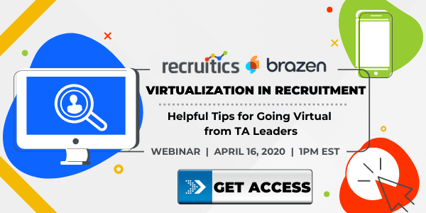Coronavirus, or COVID-19, is quickly shaping the future of how businesses operate. More and more companies are recruiting and working remotely, and digital interactions are replacing in-person meetings. However, remote work does not mean a halt in hiring or candidate engagement. Employers must adapt their recruiting processes to continue effectively attracting, engaging, hiring and onboarding talent in this new landscape.
As a result of COVID-19, we are experiencing the virtualization of recruitment. Due to shelter-in-place orders, travel bans, and social distancing, many in-person recruitment interactions have been canceled or postponed. Talent acquisition teams are turning to virtual tools to aid in their hiring initiatives. These tools that had previously been a growing trend in the industry are now recruitment essentials.
Here is a basic guide to help you navigate the many options of virtual hiring events, virtual interviews, and virtual assessment tools for recruitment and talent acquisition.
Virtual Hiring Events and Career Fairs
A virtual hiring event or career fair closely resembles the traditional in-person event. Candidates will still have the opportunity to learn about your company, culture, and the positions for which you’re hiring, as well as ‘chat’ to recruiters and hiring managers. The only difference is that the entire experience is online.
Elements of a Virtual Career Fairs
Capabilities may differ depending on the platform you’re using, but for the most part, virtual hiring events share the same basic elements:
- Landing Page: A landing page is typically where candidates must register for an event.
- Lobby: A lobby is the main event environment. From here, candidates can break out to specific “booths” to learn more about open roles, learn more about the company, and connect with a recruiter.
- Booths or Rooms: Depending on the event, there can be several booths or just one. If one employer is hosting the hiring event, each booth can be used for different job openings. If multiple employers are participating in a hiring event hosted by another organization (often hosted by third-parties, like universities, for instance), one booth is used per employer. Here, candidates typically connect with recruiters to learn more about specific opportunities via chat or video chat.
- Resume Access: Most platforms will collect resumes from candidates during their registration on the landing page. If this is not a capability, candidates can “turn-in” their resumes during the event. Recruiters would have access to all the resumes submitted for an event.
- Event Reminders: Some vendors may send automated email and/or SMS text message reminders to those who have registered.
Benefits of Virtual Hiring Events
- Accessibility: More candidates are able to attend a virtual hiring event than a physical one. With an in-person hiring event, you are limited to candidates who are in the geographic area and also have the ability to attend the event. Instead of having to worry about commuting to a physical event, a candidate can participate in an event from the comfort of their own home.
Reach: The benefit of increased accessibility allows you to cast to a wider audience. - Reduced Costs: Avoid the overhead costs associated with in-person hiring events such as travel, venue fees, and catering.
- Efficiency: Planning and organizing a virtual event can have much shorter turnaround times than a physical event. Recruiters can also hold multiple conversations with candidates at once, allowing companies to find talent more quickly.
Selecting a Virtual Event Vendor
It is important to note that there are many different types of virtual events. Hiring events are just one example. When looking into virtual event platforms, consider what use-cases the platform will need to support. Will you be using the tool solely for hiring events and career fairs? Or will you need a host that can support trade shows, conferences, keynotes, and even webinars? Or even a provider that can assist with virtual employee engagement and/or virtual employee onboarding?
Below are a few platforms to consider using to host your virtual events:
- Brazen: Brazen is a conversational recruitment platform. Ranging from a virtual career fair platform to a recruiting chatbot, Brazen’s solutions are focused on providing recruiters with a better method of connecting with candidates.
- eCareerFairs: We often recommend eCareerFairs to clients who need virtual events on an ad-hoc basis. Their simple design and process allow for quick turnaround times.
- 6Connex: 6Connex is an example of a vendor that can support different virtual event use-cases. Their platform can be used for trade shows, job fairs, summits, and more.
- ON24: If you’re looking for a “one-to-many” video platform, ON24 might be for you. Webinars and virtual company training programs are two examples of what you could do using ON24’s solutions.
- LinkedIn Virtual Events: Learn more in this article.
There are other solutions that have recently launched to help with the virtualization of talent acquisition due to the COVID-19 pandemic. These may be helpful based on your needs:
Promoting a Virtual Hiring Event
Promotional strategies are crucial to the success of any event - even virtual ones. You can utilize similar tactics to advertise virtual events. Your strategy may include direct-response tactics such as email, SMS (text messages), and other promotional solutions. You can supplement your campaign by utilizing offline tactics such as print ads and radio. Of course, it’s important to cater the recruitment marketing strategy to your specific hiring needs. Consider the market, roles you’re hiring for, and the timeline you’re working with.
Below are some partners that can help you with your virtual hiring event promotion:
Check out key things you need to know about hiring events promotions to learn more.
Virtual Interviews
Virtual interviewing is the process of conducting interviews digitally, often through video-mediated technology. There are two primary methods of video interviewing:
- Candidates record themselves answering pre-selected questions and submit the recorded video(s) to the recruiter.
- A live, two-way video communication between the recruiter and candidate. This is the most common method.
An employer might use one or the other, or even both methods in the recruitment process. While virtual interviews may be “different,” the experience can still remain pleasant for both recruiters and candidates.
Your company may already be utilizing your own video conference platform -- like Zoom Conference, Webex, GoToMeeting, or others -- to hold virtual interviews. While this is a completely valid option, there may be some advantages to partnering with a video interviewing provider. Not only do some vendors provide end-to-end support, from training to reporting, but their platforms may also utilize artificial intelligence.
When talking about virtual interviews, we need to acknowledge the unconscious bias in recruitment. Artificial intelligence (AI) can help reduce this bias by assessing the candidate strictly based on data that does not incite prejudices. AI can analyze candidate behaviors such as body language, tone of voice, and facial expressions during the interview. If bias has been an issue in your recruiting, you may want to consider using the phone instead of a video interview tool during the initial stages of the interview process.
Some video interviewing platforms include:
If you’re looking to hire based on technical skills, you may look into tech-specific interviewing platforms. Codility and HackerRank are two tech-focused platforms that allow recruiters to run remote interviews and test a candidate’s skill.
Here are some tips for implementing video interviews.
Virtual Assessments
Another technology that can help your virtual recruitment efforts are automated online assessments. Assessments are tools that help evaluate and measure a candidate’s qualifications and “company fit.” They can test different factors, depending on what is important to the role you’re hiring for.
By the end of March, more than 6.6 million people had filed for unemployment in the US. Many qualified candidates may be looking for new opportunities as a result of the coronavirus and related work displacement. With this influx of new talent into the job market, your company can benefit from the automation of the screening process with the usage of assessments in order to qualify talent easier and faster.
Learn more about the in’s and out’s of online assessments for recruitment.
Conclusion
If you have not considered “going virtual” already, now is the time to turn to a virtual recruitment plan - keeping both your employees and candidates safe. As COVID-19’s impact on the recruitment industry continues to unfold, the best course of action is to be proactive and prepared to face future changes. Rethink your HR tech stack (there are several new options out there). The sudden urgency and shift to virtual recruitment can be daunting, but we can help be a resource to the community and provide support during these unprecedented times. Contact us if you’d like to discuss how you can improve your virtual recruiting strategies - no strings attached.
And most importantly, the Recruitics team hopes that you remain safe and healthy.
GET ACCESS TO THIS WEBINAR ON DEMAND

.png?width=480&name=the%20impact%20of%20covid%20on%20talent%20acquisition%20-%20sigstr%20(2).png)


-2.png?width=520&height=294&name=Untitled%20design%20(36)-2.png)
